The post Can A Terrarium Be Sealed? (Yes, Here’s Why…!) appeared first on VivariumTips.
]]>“Can a terrarium be sealed?”
Yes, terrariums can be sealed but only under certain circumstances. To have a sealed terrarium, you will need plants that can live in a sealed environment.
Terrariums are perfect for people who live in small spaces or those who like gardening. They are beautiful, space-saving, and very low maintenance. They will be a great addition to your home or office. Specifically, terrariums are small enclosures for certain plants.
You can think of them as a mini greenhouse. They are most commonly made of transparent glass or plastic.
Do Sealed Terrariums Exist?
Yes, sealed terrariums exist, and they have a removable lid. There are also open terrariums, which do not have a lid. Sealed terrariums are like sealed gardens.
The water released by soil and plants recycles in the enclosed space.
Thus, the condensed water trickles down to the soil. They are mostly self-nourishing and require little care.
Why Sealed Terrariums?
Before you decide on building a terrarium, you need to determine if you want a sealed or unsealed terrarium. Your choice will have implications later. It will impact the longevity and aesthetics of your enclosure.
The difference is between requiring maintenance and no maintenance at all. This is the case because sealed terrariums require little care and are mostly self-caring.
They create their own water cycle. But you will have to consider the plants that you put in them as not every plant grows in a sealed terrarium.
What Makes a Sealed Terrarium?
A sealed terrarium doesn’t exchange material with the outside world. It can exchange energy in the form of light and heat. Hence, nothing goes in or out, save for air. But it is not that black and white.
Since terrariums are made in different types of containers, there is a varying degree of sealed-ness.
The terrarium with the best seal is the one in a jar with a lid that screws close.
The terrariums made in large fish tanks are very hard to seal completely. You can seal them if you put enough effort into them, but some containers are easier to seal than others.
You may need to open a sealed terrarium for watering, maintenance, or for some other reason. But once you open the lid, it will not be truly self-sustaining.
Types of Plants That You Can Use in Sealed Terrariums
Foliage plants and plants that grow slowly work best in terrariums. You should avoid fast-growing plants.
The following plants work best in terrariums:
- Ferns like maidenhair, bird’s nest, and button ferns, etc.
- Air plants like tillandsia
- Peperomia
- Mosses
- Creeping fig, etc.
Sealed Terrariums
These are the advantages and disadvantages of a seal terrarium.
Advantages
- They are low maintenance because they are mostly self-nourishing.
- They help grow plants that will be difficult to grow otherwise.
- They create and confine space for your mini garden.
- You can use lighting very efficiently.
- They look wonderful and light up your living space.
Disadvantages
- They are difficult to set up. They require proper planning; otherwise, they will collapse, and the system will fail.
- They tend to become ugly with time.
How To Care for Sealed Terrariums?
Being self-sustaining doesn’t mean that you leave them totally on their own.
Once in a while, they do need some care. Here are some tips and advice below to help you maintain a proper and better sealed terrarium.
- If you have grown ferns, then they may require trimming as they grow.
- If the leaves of your plants turn yellow or brown, that is a sign of disease; you should remove them.
- You should open the lid once in a while to let fresh air in.
Below – you can find frequently asked questions about the terrarium!
Can a plant survive in a sealed jar?
Depending what plant you add, certain plants can survive in a sealed jar. Plant create their oxygen and having the water cycle occurring in a jar can let the plant reuse them.
How long can a sealed terrarium last?
A sealed terrarium also known as a closed terrarium’s age can be depending on how much maintenance the owner puts in. There is a closed terrarium that’s been alive for at least 53 years according to terrariumtribe.com.
From VivariumTips,

You can seal your terrarium, but it may require some work on your behalf. Once you properly set it up, it doesn’t require much maintenance. Terrariums are perfect for decorating small living spaces and offices. They may be self-sustaining, but they do require some care once in a while.
Check out this video of a sealed terrarium you might like!
For terrarium-related articles, you might also enjoy reading:
- What Is A Terrarium?
- Why Is Activated Charcoal For Terrarium Necessary?
- How Often Do You Water A Terrarium?
- Can A Snail Live In A Terrarium?
- Terrarium Vs. Vivarium Vs. Paludarium
[amazon bestseller=”terrarium kit” items=”3″ ]
The post Can A Terrarium Be Sealed? (Yes, Here’s Why…!) appeared first on VivariumTips.
]]>The post What Is A Terrarium? Tips & Helpful Guide (2021) appeared first on VivariumTips.
]]>A terrarium is a miniature ecosystem that is sealed in a glass container/jar in most cases. For certain people, keeping tiny animals and having these containers unsealed can sometimes be the preferable way for their tiny ecosystem.
If you have a general idea, feel free to utilize the table of content below to help you navigate to a specific section of the terrarium.
What Is A Terrarium Ecosystem?
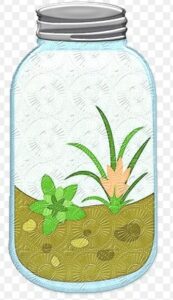
A terrarium is a tiny ecosystem filled with plants (succulents, etc.) that are stored inside of a sealed glass container. Occasionally, terrarium enthusiasts sometimes use unsealed terrarium to keep tiny living animals inside of their ecosystem. These are called closed and opened terrariums.
Let’s compare the two.
Closed Terrarium
In a closed terrarium, the jar/glass container is normally sealed with plants that are adaptable to the environment and can sometimes go for months to years without the owner having to add water. This is due to the fact that the water cycle inside of the jar. Normally, from time to time – owners of a closed terrarium would spray the closed terrarium with water to maintain it.
Opened Terrarium
In an opened terrarium, the jar/glass container doesn’t require a lid to seal it. For this type of terrarium, owners will have to maintain it more by adding water on a daily/weekly basis. Sometimes, opened terrarium owners will add small living creatures such as tiny lizards or any other animals that can withstand the environment.
Invention Of The Terrarium
The terrarium didn’t exist until nearly 200 years ago when the first terrarium ecosystem was created by a plant enthusiast, Nathaniel Bagshaw Ward. The creation of the terrarium happened in 1842 and it happened by accident.
During the time, Ward was studying insect behaviors and eventually lost interest. Ward neglected one of the jars, which eventually led to a fern growing inside of the jar. It grew into a plant, which eventually led to what we call it today – the terrarium. During the time, the terrarium was called the Wardian case.
This discovery eventually became a trend during the Victorian Era.
Vivarium Branch
If you didn’t know, a terrarium is a branch off of a vivarium. The vivarium is the general term that describes an enclosure or a place for keeping living things in an environment similar to their natural habitat.
For example, I wrote an article on the types of vivariums. While there are many more, here are the 12 that’s mentioned in the article:
- Aquarium
- Oceanarium
- Paludarium
- Riparium
- Terrarium
- Insectarium
- Orchidarium
- Formicarium
- Penguinarium
- Dolphinarium
- Jarrarium
Basic Terrarium Checklist
For potential/future owners of terrariums, here’s a basic list of what you’ll need to get started on your ecosystem.
- Jar/Glass Container
- Substrates (soil, dirt, sand, etc.)
- Adaptable Plants
- Water Spray
Lifespan Of A Terrarium
According to terrariumtribe.com, a well-researched blog specifically for terrariums stated that the longest known terrarium survived for about 53 years. The life expectancy of a terrarium depends on the type of plants, substrates, and how much maintenance is required for the ecosystem.
Terrarium FAQs
Below you can find frequently asked questions about the terrarium. If you have any additional questions about this subject and it isn’t listed in this section, please comment below and I’ll be happy to add it to this article to help future readers.
What are some reliable terrarium blogs?
As a blogger myself, I discovered terrariumtribe.com and terrariumquest.com to be quite reliable when it comes to this subject. There are numerous information about terrariums and I highly recommend that you check them out.
What is the purpose of terrariums?
There can be numerous purposes when it comes to maintaining a terrarium. Commonly, people used them as a hobby to grow an ecosystem. Terrariums are also used to study plants and how they interact in certain environments.
Is there a terrarium for kids?
While I haven’t discovered a guide created specifically for kids when it comes to terrariums, but you can find terrarium kits specifically designed for children. Just click here.
From VivariumTips,

Hopefully, this article helped you with the terrarium basics. For any additional questions or info, please comment below and I’ll get back to you as soon as possible.
To order your premade terrarium kit, be sure to check out this link to find your desired terrarium product!
For related articles, be sure to check out:
- Types Of Vivariums
- How Big Is A Vivarium? (Different Types)
- How Much Does A Vivarium Cost? (Different Types)
- Using Activated Charcoal For Terrarium
- Best Air Plant Terrarium Kits
- How Often Do You Water A Terrarium?
- Best Terrarium Books For Beginners, Adults, & Kids
- Can A Snail Live In A Terrarium?
- Terrarium Vs. Vivarium Vs. Paludarium
- Why Does My Terrarium Smell?
The post What Is A Terrarium? Tips & Helpful Guide (2021) appeared first on VivariumTips.
]]>The post My 5 Favorite Best Fish Stores In California In 2021 appeared first on VivariumTips.
]]>For veterans and beginners alike, you might be wondering to yourself:
What are the best reptile stores in California?
Don’t you worry anymore, I’m about to take you on a tour of the top reptile stores I discovered in this state.

Let’s check it out.
Disclaimer: There may be Amazon affiliate links on VivariumTips.com – When users purchase through an affiliate link, there will be no additional cost to the purchaser. Instead, I will earn a commission from your purchases.
LLL Reptile & Supply Oceanside

California is known to be famous for its glamorous lifestyle, and the glamour brings with it unique features like having reptiles in your house. Well, for well-stocked reptile stores in California, a visit to the LLL Reptile and Supply Oceanside is definitely warranted.
These are dedicated folks that not only provide you with top-notch service but also guarantee you the lowest possible prices for a vast inventory filled with supplies for reptiles.
Amongst other things, a lot of care has been taken to ensure that the reptile you are purchasing has gone through the mandatory breeding checks to identify any faults, and only the healthy reptiles are provided to customers.
LLL Reptile & Supply Oceanside – Reptile Store In California Details
- Address: 700 Seagaze Dr, Oceanside, CA 92054
- Phone Number: (760) 439-8496
- Website: LLL Reptile & Supply Oceanside
East Bay Vivarium

If you live in the Bay Area of California, then visiting East Bay Vivarium will definitely throw open new avenues for you in case you would want to keep reptiles in your house. Their quality of reptiles is unparalleled, and they only keep the best and the healthiest reptiles in their inventory.
Their selection of creatures which include pythons, constrictor boa and amphibians like poison dart frogs and fire-bellied toads are some of the best that you can find in this area.
East Bay Vivarium – Reptile Store In California Details
- Address: 1827 Fifth St c, Berkeley, CA 94710
- Phone Number: (510) 841-1400
- Website: East Bay Vivarium
Reptile Factory OC

If you happen to live around Garden Grove in California, and you are in need of the healthiest reptiles around, do visit Reptile factory OC. It has a magnificent collection that is filled with invertebrates, amphibians, and even tarantulas for you to keep in your house.
This exotic collection of reptiles does not burn a hole in your pocket; rather they are pretty cost-effective, and due to only maintaining healthy breeds, these reptiles live for a very long time. Chances are that some of the creatures that you find in the shop may not be found anywhere else in the United States of America.
Reptile Factory OC – Reptile Store In California Details
- Address: 10108 Westminster Ave, Garden Grove, CA 92843
- Phone Number: (657) 206-6940
- Website: Reptile Factory OC
Amazon Reptile Center

With an experience of 20 years under their belt, the Amazon Reptile Center has been able to maintain a good reputation in the business of selling reptiles. They house snakes, scorpions, tortoises, frogs, toads and lizards amongst other things.
The wide selection of reptiles that you would find in this store is unparalleled, and they continue to amass a lot more reptiles in order to quench the desire of hobbyists collecting them. These pets are affordable, healthy, and will live for a long period of time if taken care of properly.
Amazon Reptile Center – Reptile Store In California Details
- Address: 8851 Central Ave Ste H, Montclair, CA 91763
- Phone Number: (909) 447-5103
- Website: Amazon Reptile Center
The Serpentarium

If you are in need of good reptiles to adorn your tank in your house, then you are in luck. Having a cool name like the “Serpentarium” does not do justice to the wonderful inventory that they have for anybody serious about keeping reptiles in their house.
This store not only as reptiles but also keeps food, which could be life or grounded in the form of powder to be consumed by them. They have had a wealth of experience in running this business, and continue to share critical information with first time owners of reptiles as well when needed.
The Serpentarium – Reptile Store In California Details
- Address: 3500 Sisk Rd Ste k, Modesto, CA 95356
- Phone Number: (209) 596-4736
- Website: The Serpentarium
From VivariumTips,
Hopefully, this guide helped you find the perfect location for your reptiles!
If you by any chance visited any of the locations from the recommendations in this guide, please comment on your review below this article.
When it comes to owning reptiles, many owners raise them in a paludarium.
If you didn’t know, there are numerous types of a vivarium. Paludarium is just another branch of a vivarium.
Since paludarium is one of the more popular ones, you might want to read this:
Don’t know what kind of animals can live in a paludarium?
If you know someone that’s from California and is in search of a reptile store, you can support VivariumTips by recommending this guide! 🙂
The post My 5 Favorite Best Fish Stores In California In 2021 appeared first on VivariumTips.
]]>The post Using Springtails As Mold Control Cheat-Sheet! appeared first on VivariumTips.
]]>These creatures are pretty much useless to even exist, right?
Not necessarily. With the existence of springtails, they play a huge role in the ecosystem that you’re probably not even aware of it. The circle of life and ecosystems are all because of springtails being a great addition to the environment.
Let’s rewind a little, so you’ll get an idea of how these creatures can be used as mold control!
Disclaimer: This guide may contain affiliate links, which means that I’ll earn a commission when you purchase from it. This won’t cost you anything. By purchasing from these affiliate links, the commission will help keep this blog running with free information.
Do springtails eat mold?
Since you’re here – you’re probably wondering if springtails consume mold since the title of this article kind of spoils it.
Here’s what you should know:
When it comes to springtails consuming food, they will not consume the food directly especially with the food you are feeding. Instead, the springtails will consume the mold that grows on the food.
So yes, springtails love to feast on mold.
How to use springtails as mold control?
Whether you have a terrarium or a paludarium, you can expect that over time – mold will slowly grow.
So what’s the best way to utilize these creatures, you ask?
Step 1. First off, you need to collect springtails! You can find springtails in the wild with this guide or you can purchase them here online.
Step 2. You can introduce them to your moldy ecosystems (terrarium, paludarium, etc.)
Step 3. Over time, your springtails will consume them all.
What happens if the springtail population grows?
Nothing will happen to your ecosystem. As the springtail population grows over time and there isn’t any food left – the population will die out. This will keep a balance to your ecosystem without the worries of having a flood of springtails overtaking your build.
What do springtails eat other than mold?
Aside from being known for eating mold, springtails also eat other things that can help improve the environment. They love being in moisty conditions or areas that are damp.
So, what else do springtails consume?
You probably didn’t expect this but springtails are usually found in soil, dead plants, leaves, and wood that are rotting. The reason you find them around these types of environments is that they consume algae, dead stuff, pollen, and even fungi.
Can you find springtails in aquariums?
There’s a probable chance that you could encounter springtails in an aquarium. When springtails make contact with water, they will usually stay on the surface of the water.
Springtails can survive in water for a lengthy time. The survivability depends on whether they will be eaten by fish or other bigger creatures.
From VivariumTips,
If you didn’t know of a solution when encountering a mold problem, then I hope that this article helped you. Springtails are fantastic creatures when it comes to mold problems in your ecosystem. If you missed it, here’s a guide on how to catch springtails in the wild:
If you’re not sure if you want to go find them in the wild, you could always order a bunch of them online by clicking here.
If you enjoyed this article, don’t hesitate to comment on your feedback. I’m also glad to answer any of your questions if you have any. You can support VivariumTips by sharing any articles on this blog with your friends/family! 🙂
The post Using Springtails As Mold Control Cheat-Sheet! appeared first on VivariumTips.
]]>The post Why Is Activated Charcoal For Terrarium Necessary? appeared first on VivariumTips.
]]>Why is using activated charcoal necessary to a certain extent?
Before we get started, let’s make sure you have the right vivarium type. If not, you might want to take a look at the types of vivariums. You’d be surprised.
Over the years, more terrarium owners are advised to add charcoal to their little ecosystem – but why is that?
In this activated charcoal for terrarium guide, you will find:
- An explanation of activated charcoal
- The usage and how it goes with terrarium
- The reason why it isn’t necessary
- And much more!
Before we get started, check out this video about false bottoms! (Activated charcoal included!)
Are you ready to learn about activated charcoal for terrariums? Let’s go!
What is Activated Charcoal?

Activated charcoal is a unique dark powder created from stuff like charred bones, the shells of coconuts, or even coal.
For some terrarium owners, this is a substrate for them. If you didn’t know, activated charcoals are very absorbent, which can be beneficial in certain ways.
They can trap:
- dangerous toxins
- chemical molecules
How do activated charcoals trap the toxins and chemical molecules?
- They trap these toxins and molecules because of the charcoal’s electrical charge. Being a negative charge, they pull in a positive electrical charge, which is gas and toxins.
This is one of my favorite facts about activated charcoal. It’s pretty interesting to learn about.
Hopefully, you got something from this brief explanation of activated charcoal – let’s discuss why terrarium owners use them in their ecosystem!
Why Do People Use Activated Charcoal With Their Terrariums?
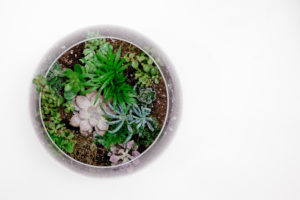
Now one question that comes to mind is “why do people use activated charcoal with their terrariums?”
While it’s not necessary, having activated charcoal can produce many positive results for your mini-ecosystem.
Results for having charcoal with terrarium:
- Removing unnecessary toxins
- Absorbs terrible smell
- Helps with drainage
The list gives you an idea, but let’s go further in-depth!
Helps With Toxin Removal
One of the positive reasons for adding activated charcoal in a terrarium is because of it being able to remove toxins.
That’s right! No terrariums need to live with toxins! 👿
As explained above, the activated charcoal creates negative electrical energy that attracts positive energy, which is toxins.
They can attract toxins and chemicals in:
- Soil
- Air
- Water
This is a great solution for people who aren’t using distilled water for their terrarium. This also doesn’t mean that you should be using unfiltered water.
In one of the guides, I mentioned the reasons why you shouldn’t be using unfiltered water.
Don’t do it. It can cause serious harm to your plants!
Helps Prevent Odor
Yes, that’s right! They can also help prevent odors and the unnecessary smell in your terrarium. You ever wondered why your terrarium smells?
Your terrarium can create a horrible smell with decaying plants and rotting roots. This problem occurs when least expected, so it’s best to be prepared and set-up properly!
The charcoal in the terrarium absorbs not only toxins but the smell inside of your ecosystem.
When your terrarium smells, you absolutely should not depend on charcoal because there is usually more than 1 problem when it comes to this situation.
Problems like:
- Rotting roots
- Watering with unfiltered water
- Decaying plants
- Overflowing of water
Helps With Drainage
Every terrarium owner knows that having a drainage layer is a necessity. This helps prevent overflowing of water, which can reduce the chances of having your plant roots rot.
Tip: Never overwater your terrarium. If it’s flooded, I recommend reading the three methods for removing excessive water.
Fortunately, you can use charcoal as a drainage layer, which serves greatly especially for a substrate.
Is Activated Charcoal For Terrarium Necessary?

While it’s necessary for some people that are in really terrible situations. It’s not really necessary for people that take proper care of their terrariums.
Yes, I’m talking about people that are watering their ecosystem properly! Why isn’t it necessary?
This isn’t only a yes or no answer – I’ll need to explain to you.
- Yes, because it’ll help tremendously.
- No, because you’ll need to change it every few weeks.
The best way for me to answer this is that it’s only necessary when you are dealing with toxins, chemicals, or using the wrong water for your plants.
What you should know about activated charcoal:
- Activated charcoal can become oversaturated once they absorb enough toxins, chemicals, and gasses.
- They don’t last forever, so it becomes powerless after a certain amount of time.
- According to a few bloggers, it’s recommended to be replaced every 2-4 weeks.
Another question I often see is about charcoal from BBQ and fire pits.
Can You Use BBQ And Fire Pit Charcoal For Terrariums?

Using BBQ and fire pit charcoal has probably crossed your mind before, but let tell you this.
You should never use BBQ charcoal for your terrarium!
This isn’t recommended because BBQ charcoal could contain other chemicals (meant for cooking and burning), which can harm your ecosystem.
If you’re in need of the right activated charcoal, you can click here. There are a bunch of other charcoal brands that are perfect for terrarium owners!
Highlighting The Important Details
- Activated charcoal is only necessary to a certain extent. The answer can’t simply be yes/no.
- Charcoal is beneficial because it removes toxins and chemicals.
- It can be a hassle to change because activated charcoal requires changing every few weeks.
- Having activated charcoal for terrarium can help with drainage.
- You can’t use BBQ charcoal because it could cause more harm than good to your ecosystem.
From VivariumTips,

Overall, I believe that using activated charcoal for terrarium can improve your ecosystem a lot. If it requires constant change, then it’s best to use it when you really need it.
Remember: Activated charcoal won’t solve all of your problems! There is usually more than one problem.
You shouldn’t depend on activated charcoal to fix your problems. If you’re terrarium smells, then there’s definitely another problem that you should take a closer look at.
Here are some helpful articles related to terrariums:
- Why does my terrarium smell?
- What can I use instead of distilled water?
- How often do you water a terrarium?
- And here’s a list of resources.
If you have any questions or feedback, don’t hesitate to comment below because this will help future readers!
The best way you can support VivariumTips.com is if you share any articles on this website with your friends.
[amazon bestseller=”activated charcoal terrarium” items=”3″ ]
The post Why Is Activated Charcoal For Terrarium Necessary? appeared first on VivariumTips.
]]>The post What Can I Use Instead of Distilled Water For My Ecosystem? appeared first on VivariumTips.
]]>This problem can occur when you least expect it.
The answer is simple – you can use purified water, reverse osmosis, or even rainwater. It sounds simple, but there are people still trying to understand how to obtain this.
And there’s more for you to know than just those simple answers.
In this article, “What Can I Use Instead of Distilled Water For My Tank” will take you a little further into helping you collect water.
The information might be useful for:
- Various types of vivariums
- Terrarium owners
- Paludarium owners
- Aquarium owners
- Jarrarium owners
- Microgreens
- and more+
Whether it’s for your plants or animals, learning these facts after reading to the end of this article will end up saving your day.
Here are the methods:
Purified Water Bottles

If you’re out of distilled water, one of the first methods I’m going to introduce to you is using purified water bottles. Yes, drinkable water bottles!
Advice: When you’re using water bottles bought from the market, you have to ensure that the water bottle isn’t mineral water.
How do I know if it’s not mineral water?
One of the ways to figure this out is by looking at the labels and read the ingredients on the water bottle. You can see what’s included or not.
Some water bottles will say “purified water” but always double-check the label because that’s where it’s most reliable.
But again – if you’re placed in a bad situation and cannot find any purified water, then you should definitely skip to the next section.
How do I test for minerals in water?
- You can test for minerals in water by using a test strip, which can be purchased online or at a local store. The test strip works when you place it inside the water and then see the color changes on the strip. The color will help you determine whether it has minerals.
Reverse Osmosis
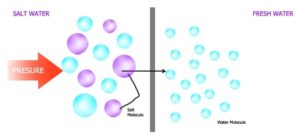
If the first method doesn’t work for you, you should definitely take a look at reverse osmosis.
How does reverse osmosis work?
Reverse osmosis works by using water with salts that are already dissolved and turning it into purified freshwater. The system uses a high-pressure pump that boosts the pressure on the salt side of the reverse osmosis.
This leaves behind the salt that you don’t want. Usually, it’s 95% to 99%.
This is a great alternative and method to have purified water for your ecosystem tank.
What can I use for this?
There are numerous products you can use for reverse osmosis. You can check it all out by clicking here. While the price can be hefty, it will provide you water in the long term.
Here are some known brands of reverse osmosis system:
- APEC Water Systems ROES-50
- APEC Water Systems ROES-PH75
- FS-TFC Reverse Osmosis
While I have one myself, I have to admit that it really does come in handy. If you pay for a system now, you can be sure to have a long-lasting supply of freshwater.
My opinion: I believe having a reverse osmosis system is perfect especially if you’re an owner of any type of vivariums. Instead of paying for distilled water, you will have water right at the comfort of your home and these systems can last for a long time.
Rain Water

This method is the classic method. You can use rainwater for your vivarium tank. If where you live rains a lot, then rainwater is going to save your day whenever you’re out of distilled water.
Maybe you won’t even need distilled water if your city rains continuously.
There are so many advantages to rainwater! You can use it to water your plants, use a bowl and collect them, and take all the advantages you want with this.
If you didn’t know this yet, watering your plants with rainwater can drastically improve the overall health of your plants.
Did you know? 💡 There’s a reason why plants appear healthier after a heavy day of rain. This is because the air is filled with nitrogen which helps the root of plants at an impressive rate.
Nature taking care of nature is the way to go!
Does rainwater have nutrients for plants?
- They have what every living animal/plant needs – nitrate. If you didn’t know, nitrate if made up of oxygen and nitrogen, which can help maximize the health of your plants.
Will heavy rain damage plants?
- Definitely! If your plant is small and fragile, heaving rain and do damage to your plants. If it’s a thunderstorm, it can be even worst.
While this is not a rain story, I remember using the water sprayer and watered my plants too hard. It did cause damage to the roots and I regret it.
Important Advice

If you really can’t get water and have no other options left. Then the last solution for you is to water your plants with whatever water you have. You don’t want to risk your plants dying just because you can’t find distilled water.
You shouldn’t turn this into a habit. You’re still going to have to try to find freshwater as soon as possible.
Using the wrong water can lead to:
- Rotting plants.
- Smelly tank.
- Problems you’re never going to expect.
I’ve written an article about this and reading this will make you realize how terrible it’ll be if you continue using the wrong water.
From VivariumTips,

Overall, these are the three powerful methods I believe could help you when you’re out of distilled water. The one method that I would recommend the most is the reverse osmosis system.
- Water Bottle – This can be costly, but it’s definitely a lifesaver.
- Reverse Osmosis – It’ll cost a lot in the beginning, but will save money in the long run.
- Rain Water – Rainwater will improve your plants’ health by a lot.
Being an owner of one of these has been saving me from ordering water from the stores. They can last a lifetime.
If you enjoyed this article, then you might also enjoy:
The best way to support this blog and continue getting free information is if you share any articles on this website with a friend!
Don’t forget to comment, leave your feedback, and ask any questions if you have! 🙂
The post What Can I Use Instead of Distilled Water For My Ecosystem? appeared first on VivariumTips.
]]>The post 7 Best Air Plant Terrarium Kits For Your Home! (2021) appeared first on VivariumTips.
]]>Look no further – I’m here to help you.
If you’re not able to buy an air plant terrarium kit, you could always make one!
This article will cover the top 10 air plant terrarium kits. There may be affiliate links in this article. Let’s begin. 🙂
Fasmov Clear Glass Vase Plant With Metal Stand
This air plant terrarium kit is by Fasmov with 2 mini globes hanging on a sturdy metal stand. With this kit, you will receive two plants inside a round-shaped glass. You can check out the price and shipping time if you click here.
Fasmov’s air plant terrarium kit has a glass diameter size of 4.7″ in diameter. For the metal stand, it’s 13.1″ in height. For the base, it’s 4.8″ in diameter.
With such a small terrarium, it’s no doubt that it’s cute having two little ecosystems hanging on a metal bar. For me, I’d be happy to have this in my office or by the window of my room.
Two air plant terrarium kit standing above the other. That’s awesome if you ask me!
Mkono 3 Pack Glass Hanging Planter
This one is actually one of my favorites. I like the way it’s designed. This air plant terrarium kit comes in three different shapes, which are teardrop, orb, and olive. How cool is that?
This air plant kit definitely adds a modern touch to your home/office and there are so many places you can hang them. You can hang them:
- By the window of your office
- By the window inside of your room
- Your backyard
- Your porch
- The entrance of your home
You can check out the price for them if you click here. In my personal opinion, this is definitely one that I like the most.
You can add many dry plants on here such as tillandsias, moss, air ferns, or even succulents. You can even be creative and use your imagination to make it appear like a mini garden.
For the size:
- The olive shape glass is 4.2″H x 4″ W with a diameter of 2″
- The earth-like shape glass is 4″ in diameter with an opening diameter of 2″
- The teardrop shape glass is 7.5″H x 3.5″ W with an opening diameter of 1.75″
This air plant terrarium kit comes with the hanging chords, so you can hang them anywhere.
This air plant terrarium kit is definitely one of the cuter ones!
Ferrisland Air Plant Terrarium Container
This one has a good number of positive ratings. If you’re interested in seeing the rating, price, and more information – you can click here.
Ferrisland’s air plant terrarium kit has a nice color to it with ventilation as you can see on the image.
With this kit, you can add:
- Cacti
- Moss
- Air Plants
- Succulents
- Microgreens
- And much more+
This can be the perfect gift for lovers of mini-ecosystems, gardening, and people that love to decorate their houses.
The size of this air plant terrarium kit is 10″ x 5.9″ x 5.1″
With this size, you can add decorations and make it look however you’d like it to be!
Mkono Geometric Shape Container
If you’re not fond of the Mkono glass shapes from earlier, how about geometric shapes? Just like the glass shape products from Mkono, this one also has many positive ratings.
You can check out the price of the Mkono geometric shape air plant terrarium kit here.
This terrarium kit comes with three shapes: Teardrop, diamond, and pyramid.
You can add all sorts of dry plants to this as well as use your own imagination to make it look astounding. This package comes with all three kits for you!
As for the size:
- The pyramid is 4″W x 5.5″H with an opening size of 4″W
- The teardrop is 4.5″W x 6″H with an opening size of 2.5″W
- The diamond shape is 3.5″W x 6″H with an opening size of 3.5″W
- The chain for these mini terrarium kit is 11″ long.
This serves as another perfect kit for terrarium and gardening lovers. I’m positive that even people who are not into gardening will love this as a gift too!
GEOLUX Set of 6 Hanging Glass


You probably have plans with your air plant terrarium kit now and you might probably want more containers! GEOLUX, another company with great ratings provides that.
You can check out GEOLUX’s rating and price right here for this.
With this product, you will get 6 glass containers perfect for your future terrarium. On each side of the globe, there’s a hole where you can add water to.
Above it, there’s another hole where you can use it to hang your air plant terrarium kit wherever you like.
With this kit, you can let your imagination run wild!
Mkono Wall Hanging Terrarium


If you’re a terrarium lover and realized how empty your wall looks. You’re probably wondering how you can add more decorations to your wall.
With the Mkono wall hanging terrarium, you can do just that! You can find more information about this product right here.
With this terrarium kit, you get round shapes containers that can hang your plants right on the wall.
You can display these in:
- your living room
- in your office
- outside of your balcony
- at the entrance of your house
This terrarium kit also comes with an air hook which makes it easy to hang your plants!
The size of this item is 5.12″ in diameter and a width of 1.57″
With the perfect size, uniqueness, and being able to hang on your wall definitely makes this the perfect gift for anyone!
ATP Modern World Map Terrarium


We’ve seen many globe shape kits already, but how about one with the map of the planet?
ATP Modern provides these really nice terrarium kits for an affordable price and not to mention – the ratings are all positive!
Click here to check out the price and rating.
When you have a beautiful terrarium, your eyes can get lost in these beautiful ecosystems – but imagine with an earth map combined!
This air plant terrarium kit only sits at 5 inches in diameter!
This is the type of kit that I would like for the inside of my office. I’d be staring at my mini-ecosystem and the map all day!
From VivariumTips,

If you enjoyed this article, have any questions or feedback – don’t hesitate to comment below!
For terrarium lovers, you might also enjoy these articles:
I have also compiled a resource page in hopes of helping all future readers out. You can find communities and forums with a click away.
The best way to support this blog for me to continue providing free information is to share any articles on this website with your friends. 🙂
The post 7 Best Air Plant Terrarium Kits For Your Home! (2021) appeared first on VivariumTips.
]]>The post How Often Do You Water a Terrarium? This Will Save You. appeared first on VivariumTips.
]]>I have gathered information from a reliable source, which mentions that you only need to water your terrarium once a month.
But wait – you’re missing out on an important piece of information.
There’s more to giving your terrarium water once a month and I’ll tell you why. This will help provide a longer-lasting life for the future of your mini-ecosystem. 💡
Before we get started, don’t hesitate to check out questions that are related to terrariums here.
If you’re reading this right now, you probably don’t want to miss the important advice that I’m about to tell you. Are you ready?
Let’s get started.
Why shouldn’t you water your terrarium based on the schedule?

As we all know it, terrariums are usually consist of dry desert plants. This means that they don’t require much water. According to many forums and trustworthy websites, the rule-of-thumb is to water your terrarium at least once a month – but…
that isn’t the correct way.
You shouldn’t water your terrarium base on the time and schedule, but rather take a look at it closely to see if it needs water. You can ask yourself the following questions in the next question, which can help you decide if your terrarium needs water.
There are certain ways to see if your terrarium needs water, but there are also different types of terrariums. This would mean that it requires different things to look out for.
This doesn’t only apply to open terrariums but also closed terrariums. If you’re unsure of whether you have an open or closed, the next section will cover it.
How do you water closed terrariums and open terrariums?
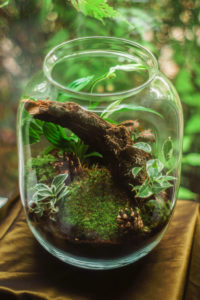
If you didn’t know yet, there are two types of terrariums which are open terrariums and closed terrariums.
- An open terrarium is a terrarium without a lid and it isn’t sealed by anything.
- A closed terrarium is a terrarium that uses a lid or requires something to seal it. Most closed terrariums are bioactive terrariums.
Watering an open terrarium: The best way to know that if your open terrarium is in need of water is to take a close look at the plants and the bottom of your terrarium. This is what you should keep an eye out for when planning to add water.
- Is there no water on the bottom of your terrarium container?
- Does the soil appear to be dry?
- Are the leaves of your plant beginning to droop?
If all these questions answer yes to you, then you should definitely water your open terrarium.
Watering a closed terrarium: As for closed terrarium, you probably know that most of them are a self-sustaining ecosystem. Still, you have to add water depending on the situation.
If there’s a little hole in your jar or container, you will never know how much water is taken from evaporation.
Most terrarium owners would recommend once a month because it’s harder for water to escape when your terrarium is closed – but here is a question you should be asking yourself when you’re thinking of watering your closed terrarium.
- The weather is warm today. Am I seeing condensation happening from the inside of my closed terrarium?
If this answers yes, then there’s no need to be watering your terrarium.
Tip: For closed terrariums, you don’t want to overflow it with water. When you have an overflowed container, it can cause plants to rot and create a disturbing smell for your terrarium.
Check out this video I found that could help you out!
What are some ways to water your terrarium?

First of all, you don’t want to flood your terrarium otherwise, it’d be causing serious problems that you’ll regret. To water it in a careful manner, you should be using these two methods that terrarium experts recommend to prevent flooding:
- Spray Bottle: By using a spray bottle, you can create a mist for the plants in your ecosystem.
- Water Can: You can also use a watering can but be careful – this can pour more water than using the spray.
When you’re watering your terrarium, it’s recommended to use demineralized water or water from the rain.
This is due to tap water containing a hint of salt that can create a build-up inside of the terrarium, which can cause harm to your plants.
By doing this, you can help your mini-ecosystem in the long run and you won’t have to be dealing with any additional issues. The problem with a flooded terrarium jar can vary and it can really cause you a lot of frustration.
- Plant rotting: It can cause your plants to rot, which you should absolutely avoid.
- Smelly Jar: Your terrarium will start to smell like rotten eggs. No thanks for that.
Obviously, you don’t want to encounter those two situations ever in your terrarium’s life.
How do you remove extra water in your terrarium container?
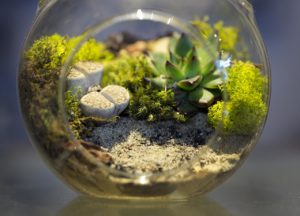
I’ve already covered this topic in the “Why does my terrarium smell” article and I highly recommend reading this. To give you an idea of draining out the extra water, there are three methods that you can try.
- Method 1: Depending on the type of container that you’re using, you can use a drill to create a hole on the bottom of the container. This will help the terrarium by having extra water leaving the bottom of that container. You can find something strong to seal the container afterward.
- Method 2: This method requires a long thing tube, which you can buy online or at a pet store. After purchasing, you have to stick one end of the tube into the water and use your mouth to create a vacuum of water exiting the other end of the tube. (the worst possible method)
- Method 3: This is one of the best and recommended methods. You can buy a drill pump and connect it to your drill. This is almost similar to method two, but you don’t have to use your mouth for this. Once connected, you can pump out the extra water from your terrarium.
The method that requires the most spending would be method three, but it’ll save you from almost drinking dirty water. 🙂
Here’s a YouTube video I found to help you out!
From VivariumTips,

Hopefully, this guide taught you how you can water your terrarium properly. If you’re in search of more informative articles related to the terrarium, feel free to check out:
- Why does my terrarium smell? Solutions + Method
- Terrarium vs. Vivarium vs. Paludarium
- Can a snail live in a terrarium?
Did you know? There are other vivariums that are related to terrariums. Check this out.
Love reading about terrariums? Here is a list of popular books that I compiled.
The best way to support this blog and get more free information is to share any articles on VivariumTips with your friends. 🙂
The post How Often Do You Water a Terrarium? This Will Save You. appeared first on VivariumTips.
]]>The post 15 Best Terrarium Books For Beginners, Adults, & Kids! appeared first on VivariumTips.
]]>“Today a reader, tomorrow a leader.”
In this book guide, I’ll help you out by providing you with the best terrarium books for adults that you can find online – to ease your life a little, of course. 🙂

There are countless studies proving the benefits of reading. This information was provided from HealthLine.com, one of the top websites that help provide medical information in bettering the well-being of an individual.
According to HealthLine, here’s how reading could help you:
- When you’re reading, it helps improve and strengthen your mind. A study has been done by using MRI scans, which confirmed it.
- By reading, it enhances your understanding to empathize.
- You’re constantly learning as you encounter new vocabularies.
- Are you stressed? Reading is known for helping with the reduction of stress.
- According to a study, researchers discovered that people who read survive two years more than those who don’t.
Did you know? 💡 There are over 129,000,000 books in existence. The great news is, you’re about to discover books on your favorite subject!
Believe it or not, there are terrarium books out there (I’m looking at you, book lovers) that will definitely make an enormous impact on your mini-ecosystem.
Not only that it’ll provide new knowledge, but it also provides benefits that you shouldn’t overlook.

From in-depth and thorough information to advice you’ve never even heard of. If you’re lost, maybe these helpful guides will reassure the facts about terrariums.
Are you ready to learn something new?
Below are terrarium books that’ll improve your well-being as well as your mini-ecosystem.
*Disclaimer: You might encounter affiliate links. From your purchases, you will not pay more nor less, but purchasing from my link will help provide free information for this blog.*
1. Terrariums: Bring Nature Into Your Home

In modern-day and age, human beings have adapted to living indoors. Today, it’s almost traditional to bring nature into your own home and terrariums provide us with an entirely new experience.
From a sphere to a three-dimensional glass window, terrarium owners can watch their mini-ecosystem grow in the comfort of their homes. In this book, Mathilde Lelievre offers instructions that are step-by-step to create your own astonishing terrarium project.
Thoughts: Here’s to a terrarium hardcover book with 96 pages of astounding information. With high quality images taken by Guillaume Czerw, you’re about to witness a great collection of unimaginable terrariums.
This book will help readers understand certain tools and help with the learning of new plants. The book also covers open and closed terrariums as well as other types of terrariums you’ve never heard of.
2. Creative Terrariums: 33 Modern Mini-Gardens For Your Home

In this book written by Enid G. Svymbersky, you will discover tons of new information that’ll help improve your terrarium. ‘Creative Terrariums’ include an easy-to-follow 33 step-by-step guide for creating your terrarium. You will find 240 pages of content in this helpful guide.
Thoughts: Terrariums are gaining awareness with the help of social media. While there aren’t much information online, this book covers the topic in-depth proving readers with powerful tips and knowledge.
You will find over 300+ quality and valuable images that’ll guide and teach you the ins and out of running a terrarium. This book will also include troubleshooting tips and techniques for plant-caring. With such a high rating, it’s a book that you definitely don’t want to miss reading.
3. Terrariums – Gardens Under Glass

“Terrariums – Gardens Under Glass” is another prestigious 176-page book written by Maria Colletti, who gives advice about designing, creating, and taking care of house plants.
This helpful book/guide is thoroughly illustrated with vibrant colors that’ll take the reader on a step-by-step tutorial with ease of understanding.
Thoughts: This helpful guide that’s flooded with valuable information makes everything easy to understand and learn. With 176 pages, the amount of information in this book comes with helpful knowledge and images that’ll help you master the art of raising your plants.
When you’re reading this guide, you will learn lawn care tips for certain landscapes, growing your plants throughout the dry season, tips for growing vegetables in a harsh environment, and filled with numerous advice.
4. Terrarium: 33 Glass Gardens To Make Your Own

This 223-page guide takes the reader into the world of terrariums. “Terrarium: 33 Glass Gardens to Make Your Own” written by Anna Bauer will take you on a journey to learning the details of creating a masterpiece for your house plants.
Thoughts: This book will help mainly terrarium lovers as well as people who have indoor plants. The guides and instruction are easy to follow, so your days of crafting the perfect terrarium are finally beginning.
This guide will help the reader fully understand the information in regards to house plants as well as going through instructions (that’s if you want to build a terrarium) on crafting your beloved terrarium.
5. Tiny World Terrariums: A Step-by-Step Guide

“Tiny World Terrariums” is a 120-page step-by-step guide written by Michelle Inciarrano and Katy Maslow to help readers learn how to create their terrarium.
Thoughts: This isn’t the type of guide that will only give you a step-by-step tutorial, but it’ll also provide data and valuable information regarding plants and containers. If you’re struggling with choosing the right container, then this book would definitely be the perfect solution.
Readers will learn about choosing the right glass containers and layering soil for their mini-ecosystem. This includes moss, succulents, and various plants that’ll captivate you from beginning to end. You will not have to deal with any more common problems, because this guide is the solution to it all.
6. Glass Gardens: Easy Terrariums, Aeriums, & Aquariums for Your Home/Office

Not every person can be perfect, and the great news is that you don’t need to be to craft an astounding terrarium to keep for display or gift. “Glass Gardens” is a 136-page book written by Melanie Flores to help readers with terrariums, aeriums, and aquariums.
This guide will help readers with easy-to-understand instructions written with a pleasant tone. This is mainly focused on new interests for terrarium building at a beginner level.
Thoughts: This book is jampacked with easy-to-understand information for new people learning about terrarium. I thought it was a pretty great idea especially when new people are entering the terrarium world every day.
You will get to learn about the process and creation of a terrarium using plants like cacti and succulents. This guide will provide you with a list of supplies, so expect scavenger hunting.
7. The New Terrarium: Creating Beautiful Displays for Plants and Nature

In “The New Terrarium“, a 176-page book written by Tovah Martin shares with you the world of gardens behind a glass. Without a doubt, terrariums are the perfect tiny ecosystem for gardeners and nature lovers.
This well-written book, filled with stunning images, shares with you about how regular gardens are reinvented with creativity in a modern way. This book is filled with useful tips and instructional guides to building and tending your very own terrarium.
Thoughts: There are numerous quality images in this book that’s worth checking out. The guide in this book gives really easy-to-follow instructions that are perfect for both beginners and intermediate terrarium lovers.
You will learn about the benefits of owning a terrarium, growing and tending of your plants, and view inspiring images of other people’s terrariums.
8. Miniscapes: Create Your Own Terrarium

“Miniscapes” is a 160-page informative guide written by Clea Cregan teaching you the ways into creating a perfect terrarium. With this book, anyone can create their own mini-ecosystem for their own enjoyment.
This instructional guide will take you step-by-step into creating your dream terrarium. The book covers 16 projects that you could learn from in addition to 4 different environments (Air Plants, Carnivorous, Desert, Forest).
Thoughts: This instructional step-by-step guide really stood out and appears to be genuinely helpful. The fact that the author covers different biomes, you get to choose the environment that would fit you perfectly.
You will learn all the tools related to creating your terrarium, substrates, and moss, and propagation. Miniscapes is definitely worth checking out if you’re stuck on deciding which environment you want to build.
9. Terrariums and Planters – 30 Stained Glass Projects

If you’re not feeling creative enough when it comes to your terrarium, then this book is something you don’t want to miss. “Terrarium and Planters” is a 68-page tutorial book written by Randy Wardell which helps terrarium enthusiasts with 30 glass project ideas.
Thoughts: This is not just any regular step-by-step terrarium book, but it comes with 30 ideas that could completely transform your current ecosystem.
In this book, there are 30 unique container designs with information that’ll cover a great range of simple plant pots to terrariums of all different sizes. Included in this guide is also advice on choosing and taking care of the right plants in terrariums.
10. A Family Guide To Terrariums For Kids

“A Family Guide To Terrariums For Kids” is a 112-page instruction book written by Patricia Buzo for children from ages 4-12 years old. This book contains 15 project ideas filled with colorful/fun images for children.
We could all agree that kids are really imaginative and love creating things. This step-by-step guide will help children understand better and learn about raising a terrarium ecosystem.
Thoughts: The fact that there’s a terrarium book written for children makes it pretty remarkable. You would think that only adults are involved in this type of project, but having a kid version of a terrarium step-by-step guide can definitely let a wider range of demographics experience having an ecosytem.
In this book, children or adults can learn to tend a bonsai tree, create an aquatic terrarium, grow a Japanese garden, and many more included.
11. Miniature Moss Gardens: Create Your Own Japanese Container Gardens

“Miniature Moss Gardens” is another interesting 128-page guide written by Megumi Oshima and Hideshi Kimura teaches plant lovers how to create their own Japanese container gardens. The guide includes bonsai, kokedama, dish gardens, and terrariums.
This guide not only covers terrariums but a variety of creations in a unique way. The author presents professional advice and tips learned from Japan, also known as the birthplace of mini-gardens.
Thoughts: I found this guide to be quite interesting because it doesn’t cover only terrariums but a lot of fascinating creations that came from another culture.
In “Miniature Moss Gardens,” readers will learn about ways to collect moss, finding the right containers, creating visual effects, finding the best plants, and many more.
12. Mindful Succulents Coloring Book: A Tiny Terrarium Coloring Book

“Mindful Succulents Coloring Book” is a 112-page coloring book illustrated by Calvin Drews perfect for kids and adults. There will be many adorable succulent images, mini terrariums, and uncolored images waiting for you and your kids.
Thoughts: I’m not going to deny the fact that there are tons of terrarium tutorial books, but seeing a coloring book definitely gives me a peace of mind knowing that they exist.
In this coloring book, there are 55 detailed line designs. I don’t think I’ve heard of anyone completing the entire coloring book. Are you up for the challenge?
13. How To Make Terrariums

“How To Make A Terrarium” is a 78-page book written by Will Kalif teaching beginners all the basics to this type of ecosystem. The author mentioned that this guide is written specifically for Kindle.
Thoughts: It’s great that the author wrote a short and simple guide and I also appreciate the fact that he included the history of terrariums. Definitely worth the read!
In this book, the chapters that are included are the history of the terrarium, how it works, plant selection, choosing containers, and taking care of it.
14. Airplant Terrarium Book Guide

“Airplant Terrarium Book Guide” is a 78-page book written by Emily Green to teach terrarium lovers the basics. In this guide, you will learn how to grow a terrarium with a money-making tutorial on how to profit from selling them.
Thoughts: At first, I thought it was another terrarium tutorial-only guide, but the author included a way to earn money from selling your terrarium. That’s definitely interesting and worth reading.
15. Modern Terrarium Studio: Design + Build

“Modern Terrarium Studio” is another great terrarium book with 128 pages written by Megan George. This book guide is unique in its own way teaching readers how to build custom landscapes with succulents and many more.
Thoughts: My thoughts on this book are that it’s pretty unique especially with the tutorials that it’s providing for the readers. You can learn tutorials with air plants, succulents, and even create your own landscapes with the information from this book.
The author presented 25 step-by-step tutorials to make different types of terrariums. The author also claimed that this isn’t your average terrariums, and now you’re wondering what it could be. Don’t let your curiosity wander. Read the book! 🙂
From VivariumTips,

Hopefully, this helped you find the terrarium book that you’re looking for. Whether it’s for kids, adults, or whomever – you’re never too old nor young to experience with terrariums.
Interested in reading articles related to terrariums? Check it out:
- Terrarium vs. Vivarium vs. Paludarium
- How Big is a Vivarium, Paludarium, & Terrarium?
- Cost of Terrarium, Vivarium, and Paludarium
The best way to support the only writer on this website is by sharing any articles with your friends! 🙂
The post 15 Best Terrarium Books For Beginners, Adults, & Kids! appeared first on VivariumTips.
]]>The post Can A Snail Live In A Terrarium? What You Should Know. appeared first on VivariumTips.
]]>
The internet helped many new people understand the meaning of terrarium including other types of vivariums, which led to a surge in questions throughout the internet with many of them unanswered.
Thousands of questions are left alone and neglected for years without a hint of traffic. 🙁

After doing a little research, there was one question that stood out to me amongst the many other questions – a question that involves snails. This person asked:
Can a snail live in a terrarium?
The answer? It really depends because the question isn’t quite specific enough. Answering a simple yes or no would mean that there are no right or wrong answers. And I’ll tell you why in a moment.
Before we get started, let’s take a brief moment and compare the differences when it comes to terrarium vs. paludarium. This is recommended and might help you with ideas if you’re planning on raising snails. To give you a brief summary between the two:
- Terrarium – a type of vivarium that’s known for its low humidity. They are usually a desert-like mini-environment.
- Paludarium – a type of vivarium that has both land and water. This type of vivarium is usually rainforest-like with high humidity.
Are you ready to get started?

Let’s begin 🙂
Keeping Snails As a Pet
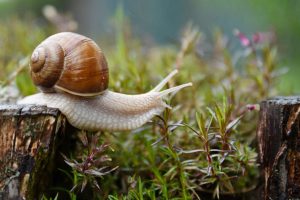
Some people hate snails and others love them with a passion. Which one are you? There are many reasons to why you should keep snails as a pet and in case you’re wondering, here are the reasons:
- Snails are quiet and a peaceful creature to have as a pet.
- There are not too many responsibilities when it comes to raising snails.
- Setting up isn’t too expensive. That’s if you don’t want to raise them in your terrarium.
- They’re one of the slowest creatures but at the same time, they’re interesting to watch.
- Having a snail is a unique pet and that’s special enough!
- Feeding them can be quite easy. You can feed them leftovers from your refrigerator!
Finding Your Snails: Where can you go?
Finding Garden Snails: You can find snails almost anywhere! Most of the time, you can find them in your garden, near your front lawn, or even next to your neighbors’ house. My grandparents have a vegetable garden and when I come for a visit, we would come across snails usually in the morning or night time.
Did you know? 💡 When it comes to the garden snail, they’re recognized as plant pests because they consume stems and leaves of crops.

But let’s say you don’t want the typical basic garden snails. Where do you find the unique looking types of snails?
- Pet store – One way you can get awesome looking snails is by going to your local pet shop. You can find a variety of snail types that’s much better looking than the garden snails.
- Order online – You could always order your snails online by clicking here.
The only difference between the two is that you have to wait for shipping when ordering your snails online. This really depends on what is more efficient for you.
Raising Snails in a Terrarium: Is it Possible?
Now for the one million dollar question – can you raise snails in a terrarium? You can answer yes or no, but you won’t fully understand until you know that there are two types of terrariums. The two kinds of terrariums would be an open terrarium and a closed terrarium.
- Open Terrarium – This type of terrarium doesn’t require lids and they’re usually open. Most of the time, this type of terrarium requires you to water the plants.
- Closed Terrarium – For a closed terrarium, you probably get the idea. This type of terrarium works with a sealed or closed lid. There are closed terrariums that are completely sealed creating a self-sustaining ecosystem with the help of the water cycle.
Even when there aren’t many responsibilities when you’re raising a snail, there will be if your terrarium is a tiny jar. For people with a terrarium tank that’s meant to keep life, then it should be much easier.

The reason why it’ll be difficult to keep your snail in a jar: When you keep snails as pets, you have to understand that they need a mix of foods. This includes calcium and protein. This is why a snail will unlikely last in a jar.
“I still want to use my jar terrarium, do I use an open terrarium or closed terrarium?”
If you still want to proceed by keeping your snails inside of a jar, then the recommended terrarium would be a closed terrarium. This will help prevent the snails from escaping. You should also add a water dish to keep water for the snails and create a hole to keep air entering and escaping for your snail.
Did you know? 💡 Wild snails can live from 2 to 5 years while snails that are kept in captivity can survive up to 15 years.
Things To Keep In Mind About Keeping Snails As Pets
Before you decide to keep a snail as a pet, either by purchasing it or rescuing it from the wild, beware that not all species can survive in a terrarium.
Only the various species of the terrestrial i.e. land snails can easily adapt to life in a terrarium.
These terrarium snails are low-maintenance and may even appreciate being taken care of.
These species can be found in the natural environment or can be bought from exotic plant dealers.
You may adopt any of the following:
- common brown garden snail
- the tiger snail
- the Helicodiscus
- and a few others
(I would advise asking the supplier details of all the terrarium species).
Snail Necessities
Since you have to feed the snail yourself, keep in mind the necessities (mainly diet):
- Water
- Calcium
- Protein
- Vegetables
- Fruits
- Etc.
However, you can feed them only once a day or every other day.
Did you know?
All the fruits and vegetables need to be thoroughly washed and dried to remove any remaining chemical or pesticides; remove the skins from hard vegetables like potatoes or fruits like apples to be extra cautious.
Moreover, if you want to give potatoes or carrots, make sure that apart from being skinned, they should also be boiled and cooled.
Don’t Forget To Cut The Products
All the products should be cut up in small pieces; remove the remaining food before it rots and unbalances the PH level of the soil, or pollute the air inside the tank with the stink of rotting produce.
Advice: You should give leafy greens in every meal.
Fruits They Enjoy
Furthermore, I have observed that these snails highly enjoy fruits like:
- Mangoes
- Bananas
- Berries
You should certainly add these to their diet.
Maintain Your Snails’ Shells
Most importantly, in order to build and maintain their delicate shells, calcium is vital for them – without which their shells could deteriorate and diminish with time.
Thus, a convenient calcium source I add to the triennium is Cuttlebones (they are easily available from stores, as they are usually fed to birds).
Tip: A convenient calcium source can also be crushed eggshells.
Lastly, protein is also important: place a small piece of meat alongside the other components of their diet.
If you have added any tank mates, critters, or earthworms, then place all the food directly on the soil and not on any plate, so the other creatures can also be sufficiently nourished.
As they can easily drown (but enjoy bathing as well), add a shallow dish; avoid bottled, chlorinated water, instead use fresh tap water.
(I boil the water and cool it down before adding it to the dish, as an extra precaution)
Since these mollusks are sensitive creatures, they should be efficiently taken care of and all the required necessities should be fulfilled.
Otherwise, they will not be able to cope with the change of their natural habitat and may die.
What You Need
The first stage is to build the terrarium: find any moderate-sized box with a lid (as snails are slow, they do not require much space to roam); a glass tank is preferable over a plastic box, but both can be used.
(I would recommend a glass tank, even if it is more costly)
Furthermore, a thick layer of soil is added as the base, this needs to be of an alkaline nature and sterilized (you can do this at home or purchase the suitable substrate from any gardening shop).
Each snail has varying behaviors, thus by observing them, various additions can be made for example adding rocks, pots, branches, twigs, etc.
Tip: Refrain from adding a water body, as they can drown.
In addition, these creatures prefer to feed on plants so add any ferns or moss in the terrarium as well; don’t use plants that require a lot of sunlight, as sunlight is detrimental for the snail’s health.
Mollusks And Humidity
These mollusks require an adequate level of humidity, not too high and not too low, for survival.
Thereby, put holes or windows in the lid of the box. You should be aware that snails can climb smooth surfaces as well; hence a lid is a necessity, no matter how high the boundaries are.
If the concentration of the plants increases (also in height), then the lid of the container is not needed, as they would climb the plants, rather than the walls of the tank.
Lastly, to keep the atmosphere of the terrarium healthy, add critters or earthworms, which maintain the cleanliness and improve the quality of the soil.
(both are harmless for the snails and their eggs!)
Avoid These With Your Snails
A few things to be avoided are the following:
- Citrus fruits and vegetables, for example, oranges, lemons, and tomatoes.
- Sharp furnishings in the tank.
- Hard materials like ceramic pots or plates; hard plants like terra cotta. (The snails may fall on them and break their shells, which is fatal for them).
Don’t forget: Another aspect to remember is that snails are nocturnal creatures, they will usually be active at night.
Thus, I would suggest that you feed them at night because if you place the produce, protein, and calcium sources in the daytime, it may start to decompose before they even feed on them (snails favor a fresh diet).
Don’t Disturb Them
Furthermore, they should not be disturbed (by being touched, removed from the terrarium, tapping on the walls of the container, placed in the light, etc.) in the daytime, as it may mess up their sleep schedule, which may be detrimental for them.
On top of that, they should be delicately handled.
I would suggest that you do not remove them from their customized terrariums (except when you clean the container).
Now, the next section is a pretty interesting one. You’ll find out why. 🙂
Boredom Made Me Calculate a Snail’s Mile Time

After spending some time researching and reading about snails, I learned that the speed of a snail is around 0.5 to 0.8 inches per second. Being the curious person that I am, I decided to take out my calculator and do a little calculation.
I found a converter that helped me convert miles to inches and discovered that one mile is equivalent to 63,360 inches. I then used the snail’s slowest time (0.5 inches per second) to do a division.
Then I added 63,360 inches into the calculator divided by 0.5 inches leaving the resulted number of 126,720. This number is how many seconds a snail can travel a minimum of one mile.
Ending up with 126,720 seconds, I divided the number by 60 seconds, which left me with 2,112 minutes. I divided 60 minutes in order to get the answer in hours and the end result was 35.2 hours. This result is this fun fact right below:
Did you know? 💡 It takes a snail a minimum of 35.2 hours to complete a full mile.
From VivariumTips,

In conclusion, terrestrial snails have a high probability of survival in trienniums; other types of snails can rarely cope with the change. You will succeed easily in keeping your pet snail alive, only if you fulfill their diet and living requirements.
If this article interests you in any way, then you might like my recent articles about aquarium shrimps.
Snail-Related Articles:
If you have any questions or feedback, don’t hesitate to comment below this post. Your comments will help provide more information for future readers.
How do I support VivariumTips?
- The best way to support this blog is to share any articles on this website with your friends.
Check this interesting video out:
The post Can A Snail Live In A Terrarium? What You Should Know. appeared first on VivariumTips.
]]>







